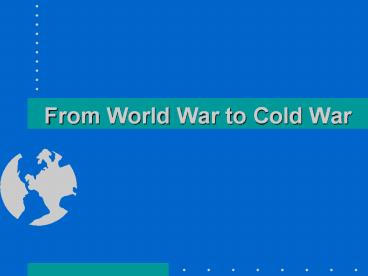From World War to Cold War - PowerPoint PPT Presentation
Title:
From World War to Cold War
Description:
From World War to Cold War Postwar Economic Concerns High Unemployment New demographics in the work force--Women, African Americans & Mexican laborers; Return of ... – PowerPoint PPT presentation
Number of Views:1103
Avg rating:3.0/5.0
Title: From World War to Cold War
1
From World War to Cold War
2
Postwar Economic Concerns
- High Unemployment
- New demographics in the work force--Women,
African Americans Mexican laborers - Return of servicemen, seeking old new
opportunities. - High Inflation
- Pent up demand following hardships of Depression
sacrifice of World War II - Expansion of national income
- Production slow to shift to consumer goods.
- Servicemens Readjustment Act (1944), propaganda,
Operation Wetback (1954) decreased the
workforce unemployment.
3
Rise of the Affluent Society
- Social Cultural Demographic trends are also
economic trends. - Rise of Consumerism--Greater disposable income
leads to purchases of new consumer goods. - Movement from Rustbelt to Sunbelt--Represented
economic shifts, rise of defense technology
industries. - Suburbanization--Culmination of all changes.
- Construction as the backbone of the economy
- New types of industries, occupations
- Gave rise to a new car culture eventual
creation of interstate highway system.
4
(No Transcript)
5
(No Transcript)
6
(No Transcript)
7
(No Transcript)
8
(No Transcript)
9
Domestic Containment
- Economic Social stability based on re-defining
or re-establishing the role of women in society - Return of the Cult of Domesticity
- New technologies in the home made it appear that
housework was easier, even glamorous - Baby Boom meant motherhood defined womens lives
- New problems created as well as experts to
solve them meant that women always had room to
improve, ie. Dr, Benjamin Spock baby care.
10
(No Transcript)
11
(No Transcript)
12
(No Transcript)
13
(No Transcript)
14
Economic Core of Foreign Policy
- Bretton Woods Conference (1944)
- Creation of World Bank International Monetary
Fund - To provide funds to war-torn underdeveloped
regions. - Marshall Plan
- US-sponsored plan for European economic recovery
- Allocated 12. Billion, intended to re-establish
Europe as consumers of American goods - Not part of Marshall Plan, Japan receives direct
assistance - Considered too expensive until fall of
Czechoslovakia. - Berlin blockade a test of economic strategic
policies.
15
(No Transcript)
16
(No Transcript)
17
(No Transcript)
18
Yalta Spheres of Influence
- Soviets break promise to allow democratic
elections - Maintained control of Poland
- Sought Eastern Europe as Buffer Zone, Iron
Curtain. - Partitioning of Korea Vietnam
- Partitioning of Germany
- Soviets sought resources of East Germany, wished
to keep Germany weak - US, France England wanted unified West Germany
to become strong capitalist democracy.
19
International Organizations
- United Nations (San Francisco Conference, 1945)
- UN Charter created General Assembly as ultimate
policy-making body - Security Council, w/US, USSR, France, China,
Britain as permanent members settled disputes
among member nations. - North Atlantic Treaty Organization
- Collective security organization to counter
threat of Soviets - Created in 1949 in response to Berlin Crisis.
- Warsaw Pact
- Response to NATO, formal organization of Eastern
Bloc countries.
20
(No Transcript)
21
Foreign Policy Doctrines
- Truman Doctrine--Containment
- Supported by the Kennan telegram warning that
Communism was inherently expansionist - Support of democracies wherever under attack
(Turkey, Greece Israel first major tests) - Many felt Truman allowed China to fall to
Communists. - Korea as ultimate test of Truman Doctrine
- Used NSC-68 to greatly expand defense spending
- MacArthur UN forces drove North Koreans back,
but Chinese support turned tide - Truman supported Limited War, but MacArthur
sought expansion (Including use of atomic bomb).
22
Foreign Policy, continued...
- Eisenhower promised to visit Korea
- Threats to use nuclear weapons moved negotiations
forward - Cease fire signed July 1953 making 38th Parallel
boundary, creating DMZ. - Domino Theory, Massive Retaliation Brinkmanship
- Encouraged liberation , even in Eastern Europe
- Emphasized preemptive strike capabilities of
nuclear weapons willingness to push right up to
brink of war - Eisenhower appeared reasonable in comparison to
Secretary of State John Foster Dulles - Origins of Mutually Assured Destruction Madman
Theory.
23
(No Transcript)
24
(No Transcript)
25
(No Transcript)
26
(No Transcript)
27
(No Transcript)
28
Easing Worsening of Tensions
- Death of Stalin Rise of Krushchev
- Offered Peaceful Co-existence but promised to
Bury American economically - Focused more on living conditions in USSR.
- Back and Forth
- Eisenhower increasingly fearful, promised to seek
uses of Atoms for Peace - Geneva Summit, suspended atmospheric testing in
1958 - Soviets crushed Hungarian Uprising
- Berlin ultimatum, Kitchen Debate, Krushchevs US
visit - US caught spying using U-2 planes.
29
(No Transcript)
30
(No Transcript)
31
(No Transcript)
32
(No Transcript)
33
(No Transcript)
34
(No Transcript)
35
(No Transcript)
36
(No Transcript)
37
(No Transcript)
38
(No Transcript)
39
(No Transcript)
40
(No Transcript)
41
(No Transcript)
42
(No Transcript)
43
(No Transcript)
44
(No Transcript)
45
(No Transcript)
46
(No Transcript)
47
(No Transcript)
























![Chapter 18: Cold War Conflicts [1945-1991] PowerPoint PPT Presentation](https://s3.amazonaws.com/images.powershow.com/7237467.th0.jpg?_=20151008125)






